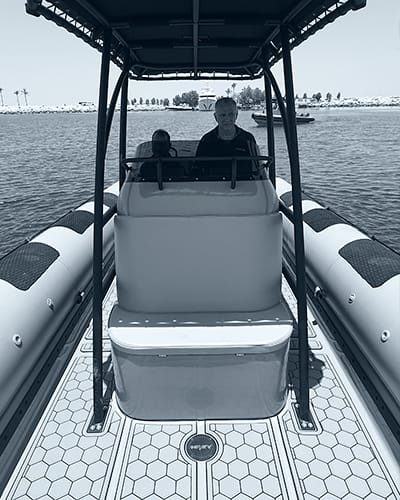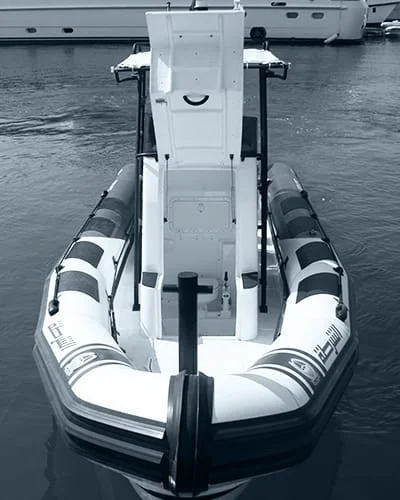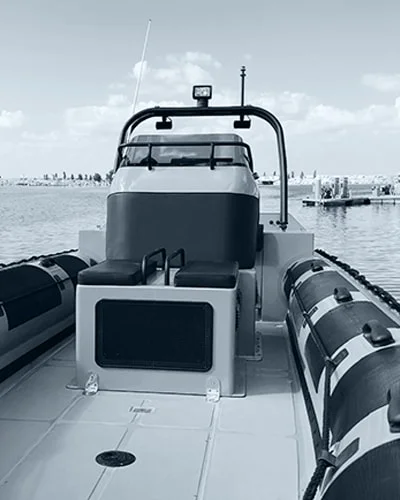Everything you need to know about Safety Boats
When it comes to water-based activities, safety is a top priority, whether for commercial, professional or recreational purposes, and especially for emergency purposes. One Essential tool that ensures safety on the water is the Safety boat. In this article, we’ll dive into the world safety boats, and Rigid Inflatable Safety Boats in particular, we’ll discuss their importance, evolution and usage.
WHAT IS A SAFETY BOAT ?
Safety boats are specialized watercraft designed to assist in emergencies, patrol waterways, transport personnel, and provide support during water-based activities. They are equipped with essential safety gear, such as communication systems, life jackets, rescue equipment, to ensure the safety of those in the water and those on board. Safety boats play a critical role in minimizing accidents and responding to emergencies in and around the water.
While having been around for many decades, and initially used by coastal communities for fishing and rescue operations, modern safety boats, as we know them today, have undergone significant evolution over the past few decades. Rigid Inflatable boats have revolutionized the safety boat industry as a whole due to their buoyancy, stability, speed and durability, making them a popular choice for rescue and emergency services around the world.
What are the different kinds of safety boats?
Safety boats are essential for ensuring the safety and equipment in and around water. There are different types of safety boats available, each with unique features that cater to specific needs and conditions. In this part of the article, we’ll go over the different types of safety boats available, the features that they have and we’ll see how they compare to each other.
- Rigid Inflatable Boats: RIBs are one of the most popular types of safety boats in the world. They are typically made of a rigid component, such as fiberglass or aluminum, and have inflatable tubes surrounding the boat. RIBs are highly maneuverable, stable, and very durable. They can be used in a wide range of sea and weather conditions, including rough seas, and are suitable for both rescue and patrol operations. RIBs are also equipped with powerful engines that allow them to move quickly through the water, making them ideal for emergency situations.
- Inflatable Boats: Inflatable Boats, or Dinghies, are typically made of flexible materials, PVC or Rubber are generally used and allow dinghies to be lightweight, easy to transport and quick to set up and deploy, making them ideal for small rescue operations. While not as stable as RIBs, they are still capable of handling mild to moderate sea conditions. They are also affordable, making them a popular choice for individuals and small organizations who need a safety boat.
- Hard-Shell Boats: Hard-shell boats are made of solid materials. They are sturdy and reliable, making them ideal for harsh conditions rescue operations. Hard-shell boats are not as maneuverable as RIBs, but they can typically carry more weight, and have larger deck spaces, making them suitable for larger rescue operations.
When it comes to comparing different types of safety boats, there are several factors to consider, such as speed, stability, maneuverability, and durability. RIBs are the most versatile of the three, offering high speed capabilities, excellent maneuverability, and stability in rough seas. Inflatable Boats are more affordable and easy to transport, but they are not as maneuverable as RIBs and are not suitable for bigger rescue operations.
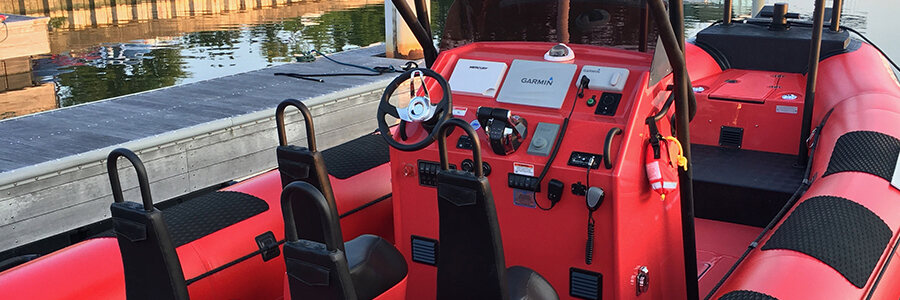
What are RIBs and how do they work?
Rigid Inflatable Boats (RIBs) are high-performance boats that have a rigid hull and inflatable tubes surrounding the boat’s perimeter. The inflatable tubes, also known as sponsons, provide buoyancy and stability to the boat. The rigid hull provides durability and strength, allowing the boat to handle rough sea conditions. RIBs can range in size from small inflatable dinghies to large military or commercial vessels. RIBs are typically fitted with powerful outboard engines and can exceed speeds of 60 knots, which makes them ideal for rescue and emergency situations.
What are the advantages of RIBs over other types of safety boats?
RIBs have several advantages over other types of safety boats. One advantage is the RIB’s high speed and maneuverability, which allows them to quickly respond to a call of distress and reach an emergency location. Rigid Inflatable Boats are also more stable than inflatable boats and can better handle rough seas. They typically have higher carrying capacities than similarly sized hard-shell boats, allowing RIBs to carry more people and equipment. Additionally, RIBs are easy to transport and launch.
What features make RIBs the perfect safety boats?
Many characteristics of RIBs make them perfect for use as safety boats. One of these characteristics is their buoyancy and stability, which reduces the likelihood that they would capsize or absorb water in choppy sea conditions. The inflatable tubes are perfect for rescue operations because they provide impact protection as well. Powerful engines are another feature that gives RIBs tremendous speed and maneuverability, enabling them to react rapidly to emergency circumstances. The boat is also more visible in the water because to the inflatable tubes, which might be helpful during rescue efforts. To ensure that they can interact with other vessels and rescue professionals, RIBs are also outfitted with navigation and communication tools including GPS, radios, and emergency beacons.
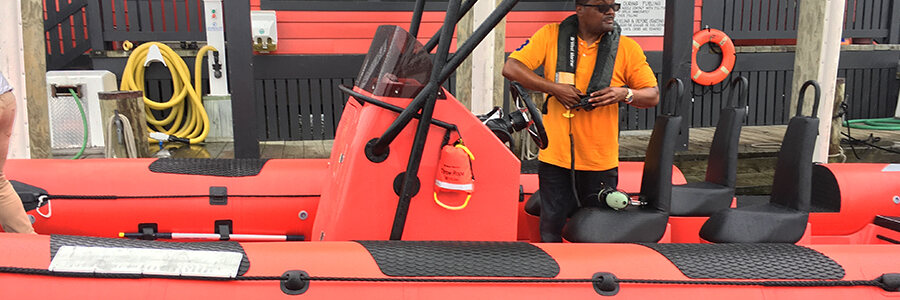
Which equipment and accessories must be on a safety boat?
Safety equipment aboard safety boats must adhere to certain regulatory standards. It is crucial to select the proper boat type and to outfit it with the necessary safety gear. Depending on the jurisdiction, and on the boat’s kind and intended purpose, different safety equipment will be needed. Personal flotation devices (PFDs) or life jackets, a first aid kit, a fire extinguisher, distress signals like flares or smoke signals, and navigation lights are some basic safety items that should be on board a safety boat. For some actions, including diving or towing, additional safety gear could be needed.
To make sure that the safety equipment on board the RHIB complies with legal standards, it is vital to check local rules and regulations.
Is maintenance really necessary ?
It is crucial to do routine maintenance and inspections on safety equipment to make sure it is in good operating order and prepared for use in an emergency. While inspecting safety gear, such as PFDs, look for any signs of damage, such as tears or punctures, and replace it if necessary. Check to see if flares and other distress signals are still operational and have not expired.
In order to keep the engine and other mechanical components of the boat in good operating order, they need also undergo routine maintenance. Frequent inspections of the safety boat and its associated equipment can aid in spotting any possible problems before they arise.
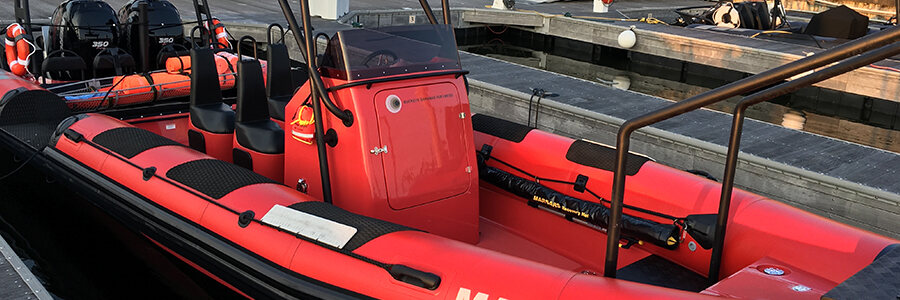
What kind of qualifications or training is needed to operate a Safety Boat?
It’s critical to possess the necessary education and experience before operating a boat so that you can carry out your duties both efficiently and safely. Depending on the nation or location, the precise training and qualification requirements may differ, however there are typically some universal standards that apply.
Operators of safety boats are normally needed to possess a current boating license or certificate at the very least. This can entail finishing a course on boating safety that goes through navigation, boat handling, and emergency procedures. In addition to these fundamental qualifications, depending on the precise function and responsibilities of the safety boat operator, extra training may be required.
Depending on their degree of expertise and the particular demands of their position, safety boat operators can choose from a variety of various methods of training. For instance, certain training courses may concentrate on particular equipment or boat types, like rigid inflatable boats (RIBs). Topics like first aid, communications, and search & rescue procedures might be covered in additional training.
.

Conclusion
Finally, safety boats play an important role in ensuring safe boating practices and protecting boaters’ lives in emergency situations. Throughout this article, we’ve discussed the various types available, the benefits of RIBs, safety equipment on board, the training and qualifications required to operate a boat, and its operations.
It is critical to note that safety equipment on board a boat should always be maintained and inspected on a regular basis to ensure that it is in good working order in the event of an emergency. Furthermore, ongoing training and skill development are essential for safety boat operators to stay current with the latest best practices and techniques.
If you want to use or operate a safety boat, you should get proper training and qualifications to ensure that you can perform your duties effectively and safely. During safety boat operations, you should also follow safety protocols and procedures and prioritize communication and teamwork.
Overall, RHIBs are an important part of safe boating practices and can greatly improve survival chances in emergency situations. We hope that this article has given you useful insights and information about safety boats and their operations.




